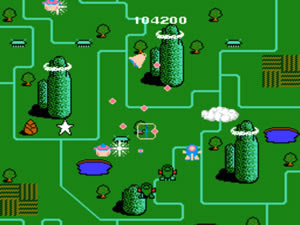 Vertical
VerticalCheckpoints OFF
7 Difficulty levels
7 Stages (loopable)
Ship speed fixed / selectable at start
- - - - - - -
Developed by Psikyo in 1993
Published by Taito in 2004
Psikyo is a shmup developer that emerged when Video System, the makers of the now classic Sonic Wings, collapsed. Much of the formula used in this title was to be passed on to Psikyo's library, starting exactly with the samurai-themed Sengoku Ace, aka Samurai Aces. This PS2 version that I played is the Japanese one, which was published by Taito bundled with the sequel Sengoku Blade in a single edition. Both titles were also released separately for the PS2 by another different company in Europe.
Being the first game released by Psikyo, Sengoku Ace surely seems subpar when compared to their subsequent titles, some of which I have already played and looped. The graphics aren't as detailed or polished, and the Japanese samurai themed music does not help to keep things moving. As primitive as it is by today's standards though, it certainly established some features what would practically become Psikyo trademarks in the shmup world, like the power-up and bomb icons (used to exhaustion in countless other titles) and the solid combination of short and intense stages with fast, varied and hard-to-dodge bullet patterns.

The character roster here is comprised of 6 fighters: two kids (Koyori and Jane), two adult samurais (Ain and Tengai), a scientist (Gennai) and a wolf (Kenoumaru). Each one of them has different characteristics for speed, bomb, main shot and charged shot. You start the game and fight 3 out of 4 initial stages, proceeding then to play 4 secondary stages, with 7 in total. From what I've noticed, the unplayed stage appears in the second loop. While CONTINUES will allow you to resume gameplay where you died in the first 3 stages, in the second part of the loop you will get back to the beginning of the level, which adds to the challenge and avoids stupid unaware people saying "the game is too easy".
You can only say Sengoku Ace is an easy game when you compare it with other Psikyo vertical shooters. Yes, it was the first, so it's reasonable they would eventually try to make things harder. However, we must be honest here: Psikyo was a lazy developer for the most part of its lifespan. If you analyze some of their releases you will notice exactly the same structure, and sometimes even same enemy designs. Here I refer to the Gunbird and Strikers series, and one of the most evident examples of this can be seen in the last stages of Sengoku Ace, which have enemies that are shamelessly reused in Strikers 1945, almost in a sprite-by-sprite reproduction! What is most astonishing is how Psikyo survived all these years sticking almost exclusively to a single formula and, more surprinsingly, achieving a respectable status among hardcore players. And to that I see only one reasonable explanation: challenge.

Sengoku Ace is challenging and offers what I already experienced in other Psikyo shooters. The learning curve is comprised of an initial wall (fast bullets, fierce rank system, shuffled stages, only 1 extend at 600.000 points), an incubation period that includes memorization and character adaptation (knowing your player, where to stand, when to charge and when to bomb) and finally something that resembles fluid gameplay. It almost seems easy after all the hard work that's put into learning how to play the game. The bonus here is that the 2nd loop is not as unforgiving as other Psikyo's 2nd loops - if you can call it a bonus anyway... Oh, and unlike the Strikers collection, Sengoku Ace & Sengoku Blade does allow high score saving.
When I started playing I used Kenoumaru the wolf, due to his spread shot and panic-style bomb. Unsatisfied with my performance, I shifted to Koyori and finally sticked with Ain for the rest of my runs. He's a weird type - I can swear he says "Heil Hitler" during the character selection screen - but his shot is very powerful at close range and his bomb also works as a panic attack. The real action started for me when I figured out some of the larger enemies could be flown over!
The high score below was achieved with him (difficulty 5 - NORMAL), playing until stage 2-3:








